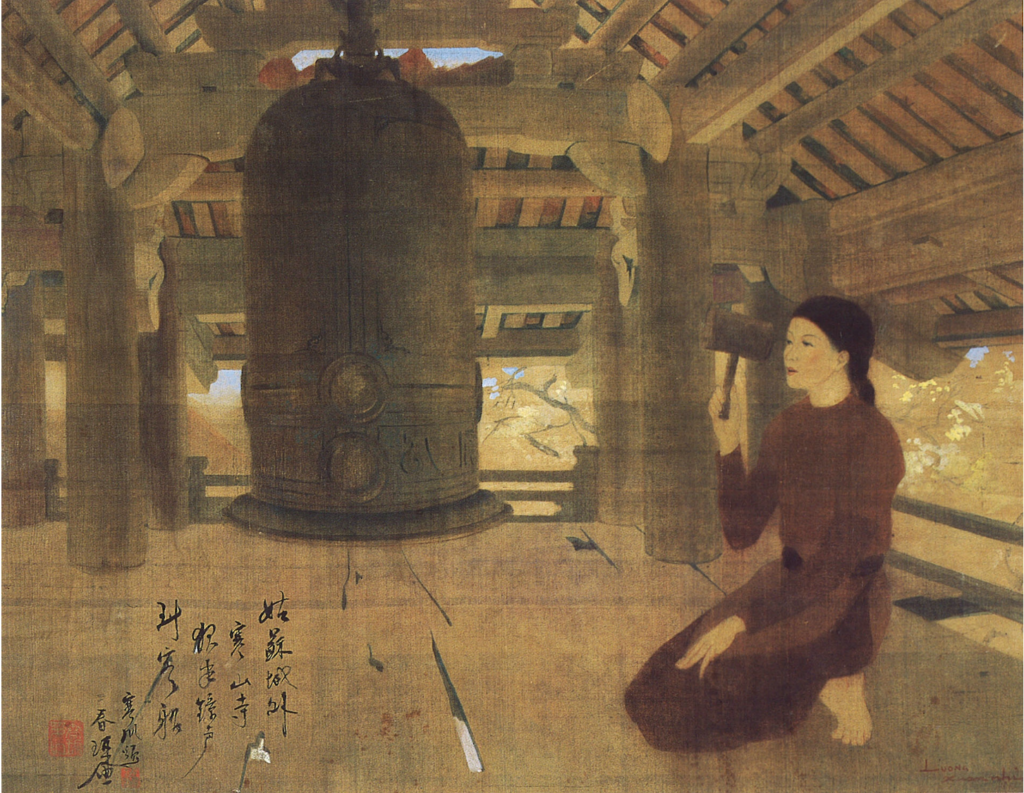Late Afternoon Chimes: a masterwork of Vietnamese painting by Luong Xuan Nhi
Luong Xuan Nhi holds a prominent place within XXth century pictorial vietnamese school: he was a graduate from the Hanoi Fine Arts School in 1937, a very active participant of the SADEAI (Société Annamite d’Encouragement à l’Art et à l’Industrie,) established in 1934, who used to organise a remarkably successful competition in which they would grant bonuses to students or graduates up to 1939.

He was also a founding member of FARTA (Foyer de l’Art Annamite) along with To Ngoc Van, Tran Van Can and Le Van De and others which will led the two Salons in 1943 and 1944. Luong Xuan Nhi left behind a particularly attractive body of work even though only a few remain, some of which are on silk.
What strikes the eye in this magnificent gouache and ink on silk is the contrast between a gentle and frail young woman compared to the massive bronze bell which takes over a vast area of the composition. The beams and the bays mark their strength even if the cracks in the floorboards show some fragility. For all his composition, excepting the dark hair shape, the painter used pigments of very soft tones in the camaïeu range of chestnut tones to diffuse a calm atmosphere. The green trees and the sky all around enhance this discreet case in which the scene takes place with all that matters: a young lady and a bell of the temple.
This very beautiful woman is not a nun, but a layperson. Her slender silhouette, her carefully chosen apparel, her long hands, her very elegant and gentle gestures, the placement of her foot, the appearance of make-up on her face distance her from peasant-women. One might think that she has come in the late afternoon to tell the weighty beads of her melancholy, it would be a simple description. But on one hand the philosophical thought so inspirational to Vietnam at that time and the symbolism always part of all the Vietnamese pictorial work in the 30’s and the 40’s, makes us believe that by striking the bell, she chants her failed emancipation as well as she chants the general social status of woman in the late 1930’s.

This major work is integrally part of the Romanticism of the pre-War period, elaborated notably by the ‘Tu Luc Van Doan’ group, a literary movement founded in 1933 by the authors Khai Hung and Nhat Linh. The former passed away in 1947, the latter committed suicide in Dalat in 1963. It is noteworthy that Luong Xuan Nhi later espoused strongly Socialist views – his biography thus being highly typical of contemporary Vietnam – as is shown by his numerous trips to Eastern European countries and his constant participation in various official bodies.
This painting also reminds us of the contribution we often neglect by reducing the birth of Vietnamese painting to a positive confrontation between the East-West, or Vietnam and France. Indeed, our Vietnamese artists also turn to Chinese painting for inspiration extracting major themes they would transform in their very own way. The phenomena is not unique to Vietnamese painting but it remains a difficult debate…
Therefore, here, Luong Xuan Nhi wrote an extract of the following poem using Chinese characters in his handwriting, ‘Nocturnal stop-over on the bridge of Maples » by Zhang Ji (712 or 715 – 779) the famous Chinese poet from Hubei who wrote:
Beyond the ramparts
« Nocturnal stop-over on the bridge of Maples » by Zhang Ji (712 or 715 – 779)
Of the old Suzhou
Cold Mount’s Monastery:
Resonates through the night
The sound of the great bell
reaches my wandering rowboat.
But let us pledge that this young woman, Vietnamese and true to her time, is thinking of the female poet Ho Xuan Huong (circa 1772-1822):
Bell of sadness, why do you ring alone?
Ho Xuan Huong
Ah! How all of thee sounds revive my suffering
And my rancor that destiny be so set against me.
Men of talent and beautiful girls, where do you meet?
This body consents not as yet to grow old
This work of a great painter at his best in his art is not only a political manifesto for future generations, a graphic poetry but mostly ‘Late Afternoon Chimes’ is a major art work of the XXth century in Vietnamese painting.
Jean-François Hubert